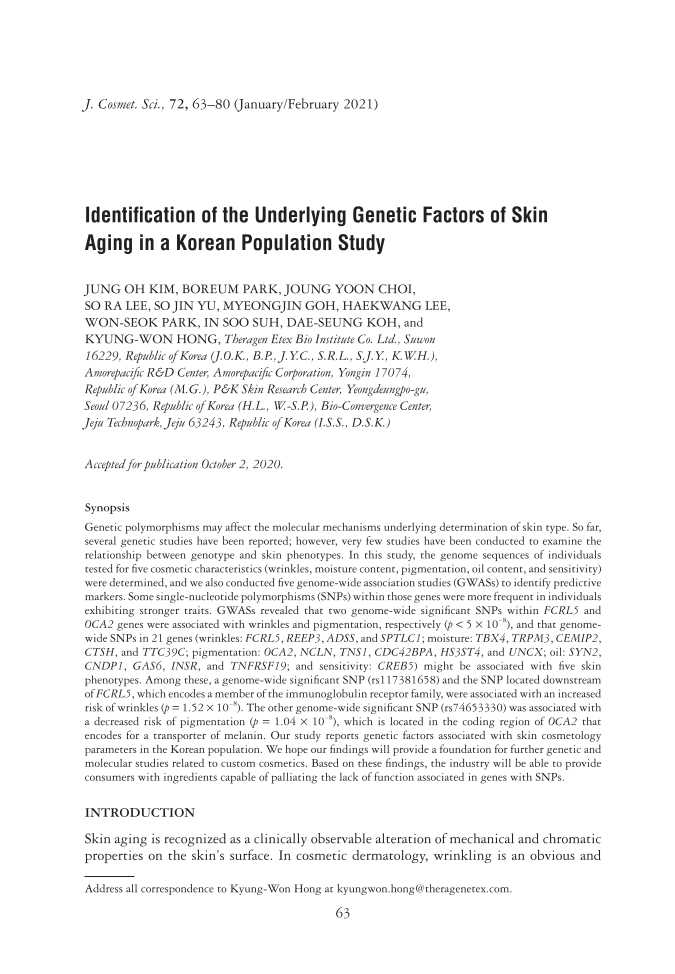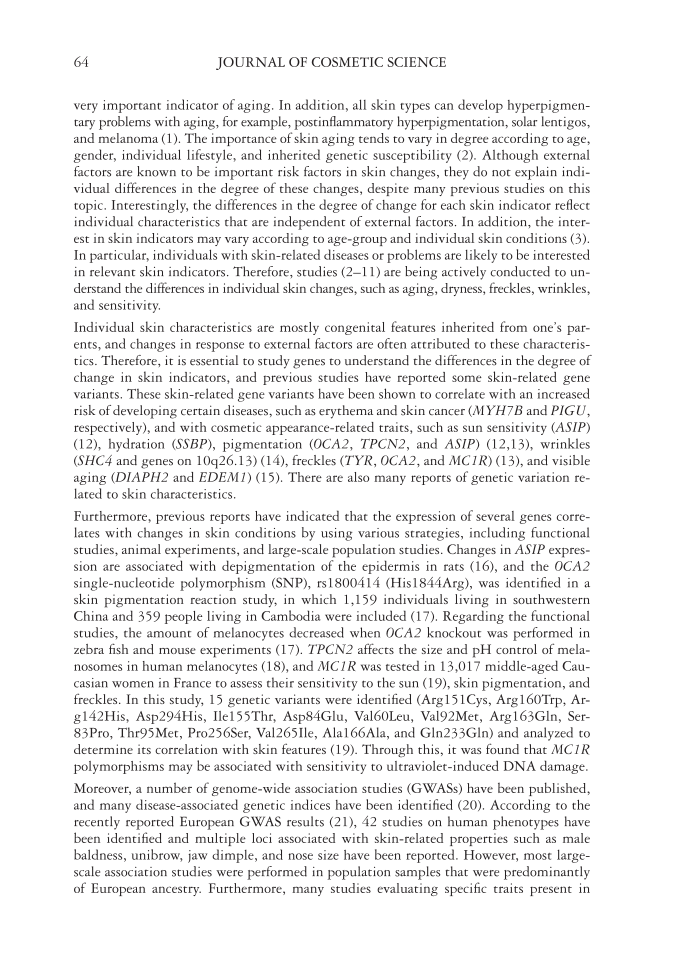J. Cosmet. Sci., 72, 63–80 (January/February 2021) 63 Identifi cation of the Underlying Genetic Factors of Skin Aging in a Korean Population Study JUNG OH KIM, BOREUM PARK, JOUNG YOON CHOI, SO RA LEE, SO JIN YU, MYEONGJIN GOH, HAEKWANG LEE, WON-SEOK PARK, IN SOO SUH, DAE-SEUNG KOH, and KYUNG-WON HONG , Theragen Etex Bio Institute Co. Ltd., Suwon 16229, Republic of Korea (J.O.K., B.P., J.Y.C., S.R.L., S.J.Y., K.W.H.), Amorepacifi c R&D Center, Amorepacifi c Corporation, Yongin 17074, Republic of Korea (M.G.), P&K Skin Research Center, Yeongdeungpo-gu, Seoul 07236, Republic of Korea (H.L., W.-S.P.), Bio-Convergence Center, Jeju Technopark, Jeju 63243, Republic of Korea (I.S.S., D.S.K.) Accepted for publication October 2, 2020. Synopsis Genetic polymorphisms may affect the molecular mechanisms underlying determination of skin type. So far, several genetic studies have been reported however, very few studies have been conducted to examine the relationship between genotype and skin phenotypes. In this study, the genome sequences of individuals tested for fi ve cosmetic characteristics (wrinkles, moisture content, pigmentation, oil content, and sensitivity) were determined, and we also conducted fi ve genome-wide association studies (GWASs) to identify predictive markers. Some single-nucleotide polymorphisms (SNPs) within those genes were more frequent in individuals exhibiting stronger traits. GWASs revealed that two genome-wide signifi cant SNPs within FCRL5 and OCA2 genes were associated with wrinkles and pigmentation, respectively (p 5 × 10-8), and that genome- wide SNPs in 21 genes (wrinkles: FCRL5, REEP3, ADSS, and SPTLC1 moisture: TBX4, TRPM3, CEMIP2, CTSH, and TTC39C pigmentation: OCA2, NCLN, TNS1, CDC42BPA, HS3ST4, and UNCX oil: SYN2, CNDP1, GAS6, INSR, and TNFRSF19 and sensitivity: CREB5) might be associated with fi ve skin phenotypes. Among these, a genome-wide signifi cant SNP (rs117381658) and the SNP located downstream of FCRL5, which encodes a member of the immunoglobulin receptor family, were associated with an increased risk of wrinkles (p = 1.52 × 10-8). The other genome-wide signifi cant SNP (rs74653330) was associated with a decreased risk of pigmentation (p = 1.04 × 10-8), which is located in the coding region of OCA2 that encodes for a transporter of melanin. Our study reports genetic factors associated with skin cosmetology parameters in the Korean population. We hope our fi ndings will provide a foundation for further genetic and molecular studies related to custom cosmetics. Based on these fi ndings, the industry will be able to provide consumers with ingredients capable of palliating the lack of function associated in genes with SNPs. INTRODUCTIO N Skin aging is recognized as a clinically observable alteration of mechanical and chromatic properties on the skin’s surface. In cosmetic dermatology, wrinkling is an obvious and Address all correspondence to Kyung-Won Hong at kyungwon.hong@theragenetex.com .
JOURNAL OF COSMETIC SCIENCE 64 very important indicator of aging. In addition, all skin types can develop hyperpigmen- tary problems with aging, for example, postinfl ammatory hyperpigmentation, solar lentigos, and melanoma (1). The importance of skin aging tends to vary in degree according to age, gender, individual lifestyle, and inherited genetic susceptibility (2). Although external factors are known to be important risk factors in skin changes, they do not explain indi- vidual differences in the degree of these changes, despite many previous studies on this topic. Interestingly, the differences in the degree of change for each skin indicator refl ect individual characteristics that are independent of external factors. In addition, the inter- est in skin indicators may vary according to age-group and individual skin conditions (3). In particular, individuals with skin-related diseases or problems are likely to be interested in relevant skin indicators. Therefore, studies (2–11) are being actively conducted to un- derstand the differences in individual skin changes, such as aging, dryness, freckles, wrinkles, and sensitivity. Individual skin characteristics are mostly congenital features inherited from one’s par- ents, and changes in response to external factors are often attributed to these characteris- tics. Therefore, it is essential to study genes to understand the differences in the degree of change in skin indicators, and previous studies have reported some skin-related gene variants. These skin-related gene variants have been shown to correlate with an increased risk of developing certain diseases, such as erythema and skin cancer (MYH7B and PIGU, respectively), and with cosmetic appearance-related traits, such as sun sensitivity (ASIP) (12), hydration (SSBP), pigmentation (OCA2, TPCN2, and ASIP) (12,13), wrinkles (SHC4 and genes on 10q26.13) (14), freckles (TYR, OCA2, and MC1R) (13), and visible aging (DIAPH2 and EDEM1) (15). There are also many reports of genetic variation re- lated to skin characteristics. Furthermore , previous reports have indicated that the expression of several genes corre- lates with changes in skin conditions by using various strategies, including functional studies, animal experiments, and large-scale population studies. Changes in ASIP expres- sion are associated with depigmentation of the epidermis in rats (16), and the OCA2 single-nucleotide polymorphism (SNP), rs1800414 (His1844Arg), was identifi ed in a skin pigmentation reaction study, in which 1,159 individuals living in southwestern China and 359 people living in Cambodia were included (17). Regarding the functional studies, the amount of melanocytes decreased when OCA2 knockout was performed in zebra fi sh and mouse experiments (17). TPCN2 affects the size and pH control of mela- nosomes in human melanocytes (18), and MC1R was tested in 13,017 middle-aged Cau- casian women in France to assess their sensitivity to the sun (19), skin pigmentation, and freckles. In this study, 15 genetic variants were identifi ed (Arg151Cys, Arg160Trp, Ar- g142His, Asp294His, Ile155Thr, Asp84Glu, Val60Leu, Val92Met, Arg163Gln, Ser- 83Pro, Thr95Met, Pro256Ser, Val265Ile, Ala166Ala, and Gln233Gln) and analyzed to determine its correlation with skin features (19). Through this, it was found that MC1R polymorphisms may be associated with sensitivity to ultraviolet-induced DNA damage. Moreover, a number of genome-wide association studies (GWASs) have been published, and many disease-associated genetic indices have been identifi ed (20). According to the recently reported European GWAS results (21), 42 studies on human phenotypes have been identifi ed and multiple loci associated with skin-related properties such as male baldness, unibrow, jaw dimple, and nose size have been reported. However, most large- scale association studies were performed in population samples that were predominantly of European ancestry. Furthermore, many studies evaluating specifi c traits present in
Purchased for the exclusive use of nofirst nolast (unknown) From: SCC Media Library & Resource Center (library.scconline.org)



















































































































































